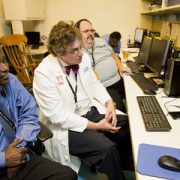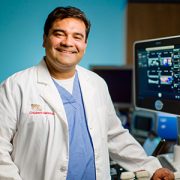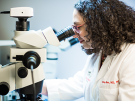Eliminating unnecessary radiation exposure from spinal radiography

Chief of Orthopaedics and Sports Medicine Matthew Oetgen, M.D., discusses an image of a patient’s spine.
If a child arrives at the pediatric orthopaedic specialist for an idiopathic scoliosis evaluation without an adequate radiographic image of his or her spine, it’s often necessary to order yet another imaging study for accurate assessment.
A study published in the Journal of the American Academy of Orthopaedic Surgeons found that in a 6 month period, almost half (43 percent) of patients referred for evaluation required a repeat radiograph due to missing or poor quality existing images.
“Repeating the radiograph means these kids received another exposure to radiation, too,” says Matthew Oetgen, M.D., the study’s lead author and chief of Orthopaedic Surgery and Sports Medicine at Children’s National Health System. “It’s frustrating because in many cases, a simple change in how the initial radiograph was taken could have prevented the need for more imaging studies.”
Dr. Oetgen and the study authors note that there is currently no standardized protocol for spinal radiography of suspected idiopathic scoliosis. However, a few basic criteria could greatly reduce the number of repeat images necessary. Radiographic images that allow for proper evaluation of idiopathic scoliosis and reduce radiation exposure include:
- A full coronal view of the spine including skull base and pelvis
- The iliac crest as an indicator of skeletal maturity
- A full-length lateral view of the spine
Study authors also reinforced the need to do everything possible to reduce radiation exposure for children through proper use of protective shielding for reproductive organs and digital radiograph technology.
“Orthopaedic surgeons and pediatricians share the responsibility to ensure children are exposed to as little iatrogenic radiation as possible,” Dr. Oetgen concludes. “All physicians should be sure that the radiology facilities they refer patients to for spinal radiography employ every technology and safety measure available to limit radiation exposure. Additionally, we can and should work with radiologists to define evaluation criteria and improve what’s captured by radiography on the first try.”











